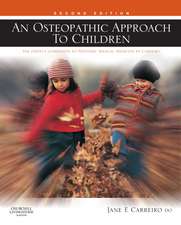Developing Ocular Motor and Visual Perceptual Skills: An Activity Workbook
Autor Kenneth Laneen Limba Engleză Paperback – feb 2005
To establish a framework for understanding, each chapter begins with the scientific theories used to develop the activity forms. Insightful suggestions are included on how to solidify the program's success.
The easy-to-follow activity forms are then presented, along with numerous illustrations that help develop ocular motor and visual perceptual skills. The forms are divided into as many as five levels of difficulty so both children and teenagers can benefit from each activity.
Developing Ocular Motor and Visual Perceptual Skills contains daily lesson plans and practical tips on how to successfully start an activities program. Other helpful features include a glossary of terms and a reference list of individuals and organizations that work with learning disabled children to develop these skills.
The first of its kind, Developing Ocular Motor and Visual Perceptual Skills utilizes a learning approach by linking the theories with the remediation activities to help learning disabled children improve their perceptual and fine motor skills. All professionals looking to assess and enhance a variety of fine motor and visual perception deficiencies will welcome this workbook into their practices.
Topics include:
- Complexity of reading
- Ocular motor
- Gross motor
- Visual-motor perception
- Visual memory
- Laterality
- Reversals
| Toate formatele și edițiile | Preț | Express |
|---|---|---|
| Paperback (1) | 573.49 lei 6-8 săpt. | |
| Taylor & Francis – feb 2005 | 573.49 lei 6-8 săpt. | |
| Hardback (1) | 978.92 lei 6-8 săpt. | |
| Taylor & Francis – 4 noi 2024 | 978.92 lei 6-8 săpt. |
Preț: 573.49 lei
Preț vechi: 603.68 lei
-5% Nou
Puncte Express: 860
Preț estimativ în valută:
109.83€ • 112.07$ • 92.40£
109.83€ • 112.07$ • 92.40£
Carte tipărită la comandă
Livrare economică 26 februarie-12 martie
Preluare comenzi: 021 569.72.76
Specificații
ISBN-13: 9781556425950
ISBN-10: 1556425953
Pagini: 314
Dimensiuni: 210 x 280 x 20 mm
Greutate: 0.91 kg
Ediția:Workbook
Editura: Taylor & Francis
Colecția Routledge
Locul publicării:Oxford, United Kingdom
ISBN-10: 1556425953
Pagini: 314
Dimensiuni: 210 x 280 x 20 mm
Greutate: 0.91 kg
Ediția:Workbook
Editura: Taylor & Francis
Colecția Routledge
Locul publicării:Oxford, United Kingdom
Public țintă
Professional Practice & Development, Undergraduate Advanced, and Undergraduate CoreCuprins
Contents Dedication Acknowledgments Preface Chapter 1: How to Use This Book Chapter 2: The Complexity of Reading Chapter 3: Eye Movements and Reading Chapter 4: Ocular Motor OM-1: Colored Overlays OM-2: Figure Ground OM-3 :Static Fixation OM-4: Line Counting OM-5: Fixation Activities OM-6: Four Corner Fixation OM-7: Pencil Pursuits OM-8: Number Pursuits OM-9: Global Scanning OM-10: Letter Search OM-11: Words in Words OM-12: Visual Scanning OM-13: Yardstick Fixations OM-14: Pencils With Numbers OM-15: String Reading OM-16: Near-Far Letter Naming OM-17: Baseball Fixations OM-18: Spatial Attention OM-19: Peripheral Training OM-20: Marsden Ball OM-21: VMC Bat OM-22: Brock String OM-23: Pursuit Reading OM-24: Dictionary Training OM-25: Board-Book Reading OM-26: Orthography Activities Chapter 5: Gross Motor GM-1: One Foot Hop GM-2: Stepping Stones GM-3: Heel and Toe Rock GM-4: Pattern Hopping GM-5: Gross Motor Balance Sequencing GM-6: Foot Tapping GM-7: Bean Bag Basketball GM-8: Crawling Activities GM-9: Marine Crawl GM-10: Creeping Activities GM-11: Colored Squares GM-12: Head Tilt GM-13: Eight Square Bouncing GM-14: Letter Tracking and Bouncing a Ball GM-15: Activities for Ball Bouncing GM-16: Beanbag Activities GM-17: Balance Board on Hands and Knees GM-18: VMC Bat While Balancing GM-19: Tape Walking GM-20: Walking Rail / Balance Beam GM-21: Trampoline GM-22: Jump Rope Activities GM-23: Rhythm GM-24: Rhythm - 2 GM-25: Finger to Thumb GM-26: Dual - Task GM-27: Rhyme/Sound Categorization GM-28: Mental Rotations GM-29: Visual Imagery Chapter 6: Visual Motor Perception VMP-1: Bean Counting VMP-2: Nuts and Bolts VMP-3: Line Drawing VMP-4: Flashlight Activities VMP-5: Angles and Oblique Lines VMP-6: Proximal and Distal Kinesthetic Reinforcement VMP-7: Motor Planning VMP-8: Kinesthesia VMP-9: Finish the Designs VMP-10: Geoboards VMP-11: Dot Pattern Designs VMP-12: Can You Imagine a Shape? VMP-13: Matchsticks VMP-14: Lines and Shapes VMP-15: Round Paper Drawings VMP-16: Occluded Vision Copying VMP-17: Triangle and Square VMP-18: Bimanual Coordination VMP-19: Continuity VMP-20: Points and Continuity VMP-21: Handwriting Development VMP-22: Letter Size Spelling VMP-23: Frequently Difficult Letters VMP-24: Pencil Grip Relaxation VMP-25: Mirror Image Activities VMP-26: Eye-Hand and Fine Motor Control VMP-27: Space Matching VMP-28: 3-D Tic-Tac-Toe VMP-29: Spatial Relationships VMP-30: The Relationship of Surrounding VMP-31: Linear and Circular Order VMP-32: Knots VMP-33 Vectors Chapter 7: Visual Memory VM-1: Identifying Digit Span VM-2: Clock Memory Game VM-3: Auditory Span VM-4: Color Sequencing VM-5: Sequence Memory Skills VM-6: Rhythm VM-7: Hand Sequencing VM-8: Digit Span/Spatial Task VM-9: Sentence Endings VM-10: Daily Memories VM-11: Motor Sequencing VM-12: Upper and Lower Case VM-13: Semantic Association VM-14: Chunking VM-15: Number Scans and Math VM-16: Colors for Directions VM-17: Scan Memory VM-18: Visual Spatial Memory VM-19: Initial Blends VM-20: Sign Language Alphabet VM-21: Word List/Two Second Span VM-22: Consonants VM-23: Verb Generation VM-24: Grid Dots VM-25: Word Shapes A VM-26 Dual Task VM-27: Word Shapes B Chapter 8: Laterality L-1: Head Roll L-2: Body Roll L-3: Maze Game L-4: Flashlight Walking L-5: Walking Procedure L-6: Numbered Circles on Marker Board L-7: Angels in the Snow L-8: Coding on Marker Board L-9: Tactile Reinforcement L-10: The Clock Game L-11: Midline Training L-12: Reciprocal Movements L-13: Tic-Tac-Toe L-14: Xs Procedure L-15: Arrows on Board L-16: Vertical Lines L-17: Body Awareness L-18: Laterality Coding L-19: Directional U Saccades L-20: Directional Arrows Chapter 9: Reversals Rev-1: Letter Orientation Rev-2: B-D-P-Q Sorting Rev-3: Directional U Saccades Rev-4: Directional Arrows Rev-5 Teach Letters by Classes Rev-6: Flash Cards and Reversed Letters Rev-7: Fill in the Loops Rev-8: The Bed Rev-9: Vectors Rev-10: Commonly Reversed Words Rev-11: Distinctive Features Rev-12: Bilateral Circles Rev-13: Marker Board Squares Rev-14: Figure Eights Rev-15: Triangle and Square Rev-16: Felt Letters Rev-17: Magazine Letter Hunt Chapter 10: Examples of Daily Lesson Plans Glossary of Terms Appendices A: Questionnaire B: Important Names and Addresses Index
Recenzii
"Professionals who are looking for a way to assess and address a variety of fine motor and visual perception deficiencies will welcome this workbook into their practices. The book will be of help to parents and teachers as well."
— Savannah Jones, Review Editor, SirReadaLot.org "...if you are in need of suggested activities and possible ways of developing interventions, this text can serve as a starting point."
— Leonard G. Trujillo, PhD, OTR/L, East Carolina University Occupational Therapy in Healthcare
— Savannah Jones, Review Editor, SirReadaLot.org "...if you are in need of suggested activities and possible ways of developing interventions, this text can serve as a starting point."
— Leonard G. Trujillo, PhD, OTR/L, East Carolina University Occupational Therapy in Healthcare
Notă biografică
Kenneth A. Lane, OD is a doctor of optometry and a fellow with the College of Optometrists in Vision Development. Since his first book, Reversal Errors: Theories and Therapy Procedures, in 1988, Dr. Lane has published Developing Your Child for Success, and a series of workbooks that deal with eye tracking and perception. He started the Lane Learning Center to help learning-disabled children in 1980. Visual Attention in Children: Theories and Activities is the result of 3 years of research. Dr. Lane lives with his wife, Janet, in north Texas and spends his leisure time in Ruidoso, New Mexico.
Descriere
With over 20 years of experience, Dr. Kenneth A. Lane has designed Developing Ocular Motor and Visual Perceptual Skills: An Activity Workbook to help occupational therapists, optometrists, and other professionals develop the ocular motor and visual perceptual skills of learning disabled children.




















